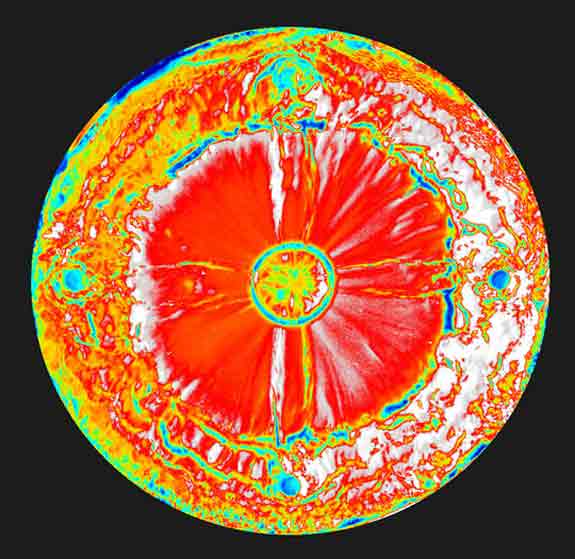The Poppy: An Imploding Circular Water Wave
Anna Shchetinina
Hoi Dick Ng
Department of Mechanical and Industrial Engineering
Concordia University
Montréal, Canada

Snapshot of an imploding circular water wave with four cylindrical obstacles in its path
The implosion of surface waves is ubiquitous in nature, and provides an important analogy for many physical phenomena. For example, when a heavy solid object (such as a meteroid) impacts a fluid surface (such as the planet’s ocean), a crater is created and subsequently begins to pinch radially inward, resulting in the formation of a vertical water jet (Gekle et al. 2009). Surface wave implosion also has an analogue in nuclear energy fusion, where gasdynamic shock waves are imploded to generate dense plasmas of extremely high temperature at the center (Perry and Kantrowitz 1951).
In the image, the dynamics of an imploding circular water wave are simulated experimentally using a simple gate-type water table and high-speed video imaging. A circular, converging water wave is created by rapidly retracting a gate separating a region of high water level from a region with lower water level. Four cylindrical obstacles are placed in the path of the collapsing wave to test the stability of the imploding wave. The figure shows a sample snapshot of this implosion process just before the wave breaks at the center, visualized from the bottom of the water table. The center of convergence of the water wave coincides with the center of symmetry of the implosion. The transient, inward-sweeping turbulent flow created by the retracting gate, as well as the outward-sweeping trajectory of the disturbances on the water wave caused by the four cylindrical obstacles, can be seen and traced. Artistically, the implosion core resembles the shape of a remembrance poppy.
We gratefully acknowledge the help of A.J. Higgins and C.B. Kiyanda to this project. This research is supported by the Natural Sciences and Engineering Research Council of Canada.
References
- Gekle, S., Gordillo, J.M., Van der Meer, D. and Lohse, D. (2009) High-speed jet formation after solid object impact. Phys. Rev. Lett. 102, 034502
- Perry, W.R. and Kantrowitz, A. (1951) The production and stability of converging shock waves. J. Appl. Phys. 22:878–886
Reporters and Editors
This image can be freely reproduced with the accompanying credit: "A. Shchetinina & H.D. Ng (Concordia University, Montréal, Canada)."
